
Sawfish
Sawfishes belong to a group of fishes called elasmobranchs that includes sharks, rays, and skates. All Elasmobranchs have a skeleton made of cartilage as opposed to a skeleton made of bone like other fishes such as red drum, snook, or tarpon. Sawfishes are actually a type of ray. Sawfishes all fit into one family known as Pristidae, derived from a Greek term meaning "saw". Sawfishes possess the characteristic long, flattened, toothed saw, a flattened head and trunk, and a shark-like appearance and manner of swimming.
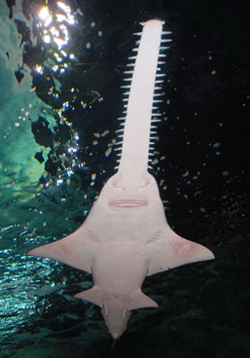
Once lost, the teeth along the saw are not replaced. Sawfishes worldwide are poorly studied and no one knows for sure the number of living species, but there are an estimated four to seven species worldwide. The two species that exist in the western side of the Atlantic Ocean are the smalltooth sawfish (Pristis pectinata) and the largetooth sawfish (Pristis perotteti). The two species can look very similar, but can be distinguished by counting the saw teeth on either side of the saw. The smalltooth sawfish usually has 23-34 teeth per side and the largetooth sawfish usually has 17-22 teeth per side. The ranges of both species have been reported to include Florida, but only three specimens of the largetooth sawfish have ever been reported from Florida. The typical range of the largetooth sawfish is further south and west of the state. The smalltooth sawfish is by far the most often reported species of sawfish on both coasts of Florida. Hundreds of specimens have historically been reported throughout Florida, but in the last decade or so most have been reported from southwest Florida.
Distribution and Abundance
The smalltooth sawfish ranges in the western Atlantic from Brazil to Florida, including the Gulf of Mexico. It is a year-round resident of peninsular Florida and can be found in the warm summer months as far north as North Carolina, rarely straying to New Jersey. Smalltooth sawfish were once common throughout Florida waters, especially in the late 19th century to early 20th century. In the late 1800’s one fisherman from near the Indian River reported capturing 300 sawfish in his net during one season. Others reported seeing hundreds of sawfish "big and little" along the west coast of the peninsula. Although no published studies specifically documented sawfish population decline, it is thought that commercial fishing activities (e.g., gillnets, otter trawls, seines), directly and indirectly contributed to the problem.
Because of their body shape, sawfish became easily entangled in these gears. They were dangerous to handle while alive, did considerable damage to nets, and had minimal commercial value. Most specimens captured probably either suffocated or were killed. To a lesser extent, sportfishing activities may have also negatively impacted sawfish populations in Florida because sawfish saws have historically been a popular curio item.
Mortality through being caught as bycatch combined with their limited reproductive potential is what scientists believe caused the reduction in the size of the population of Florida’s sawfish in the latter half of the twentieth century. Because of this, sawfish have been protected from harvest in Florida since 1992. Most recently, on April 1, 2003 the U.S. population segment of smalltooth sawfish was declared an endangered species by the National Marine Fisheries Service. This declaration gives the U.S. population of this species federal protection under the Endangered Species Act, effective May 1, 2003.
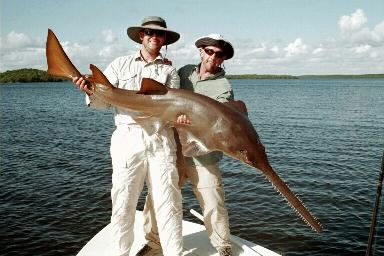
This 7 ft (2.1 m)sawfish was caught and released by F. Perez while fishing Whitewater Bay over a seagrass bed
Life History and Biology
Sawfish feed on crabs, shrimps, and other bottom dwelling animals along with any locally abundant small schooling fishes such as small mullet or members of the herring family. The saw is used in obtaining food by disrupting the bottom and dislodging any prey items that may be available. They probably also slash through schools of small fishes, stunning or lacerating them before they are consumed. Sawfish, like other bottom dwelling rays, can be opportunistic and will bite a hook or jig head baited with fresh or frozen cut or whole dead bait, live fish or shrimp, and occasionally one is caught on a lure or while fly fishing. Sawfish can also use their saw for defense, because they are tremendously powerful from side to side.
Care must be taken when handling or approaching a sawfish of any size. Although sawfish may defend themselves when they feel threatened, the only evidence of unprovoked attacks on humans by sawfish that authors know of, is an attack on a wader off the Yucatan coast, where a small sawfish (3 feet, 0.9 m) had apparently slashed at and wounded the man's legs. Other attacks on man, most or all of which were almost certainly provoked, have been documented in Panama City Bay, and one unreliable report of a fatal attack off the coast of India.
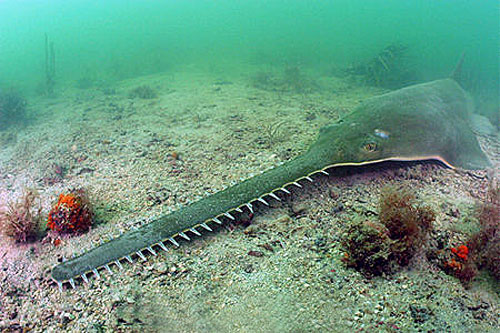
Very little is known about size, age, maturity, and reproduction of sawfish in Florida. The smalltooth sawfish has been reliably measured at a length of 18 feet 13/4 inches (5.5 meters), but may grow to over 20 feet ( 6.1 m). A 16 foot long (4.9 m) specimen weighed 700 pounds (317 kg). The size at maturity for the smalltooth sawfish is not known, but the largetooth sawfish (males and females) in Lake Nicaragua reaches maturity at about 10 feet (3 m). Sawfish have internal fertilization, such as in all sharks and rays. The eggs of the sawfish hatch in the uterus and the embryos continue to grow in the uterus without a placental connection with the mother. The embryos are nourished by yolk stored in a yolk sac, connected to the embryo by a yolk stalk and both of these structures are fully absorbed before the young sawfish are born.
The gestation period of the smalltooth sawfish is not known, but the largetooth sawfish has a gestation period of about five months. Young smalltooth sawfish are probably born in late spring through summer in south Florida. Up to 20 young have been reported in a litter, and each may measure between 1.5 and 2.5 feet (0.5-0.8 m) in total length. The saw teeth of young sawfish do not fully erupt (and may also be covered in a sheath made of tissue) until after birth so as not to injure the mother, but their teeth reach their full size proportionate to the size of the saw soon after birth. The saw teeth of a sawfish are actually not teeth at all, but rather are modified scales known as dermal denticles. The reproductive cycle of the smalltooth sawfish is not known, but the largetooth sawfish has been reported to produce litters every second year. Both species grow slowly, and may not reach maturity until at least 10 years of age and may live to 30 or more years of age.
Florida’s sawfish are most often found within a mile of land such as in estuaries, river mouths, bays, or inlets.In Biscayne Bay they were plentiful but now are rarely seen.They occur in a wide range of habitat types including grass flats, mud bottoms, along oyster bars, sand bottoms, artificial reefs, under or adjacent to mangrove shorelines, associated with docks, bridges, or piers. They can also be found miles up rivers in low salinity conditions. Large sawfish can occasionally be found offshore living in close association with artificial reefs or wrecks, hard bottoms, or mud bottoms.
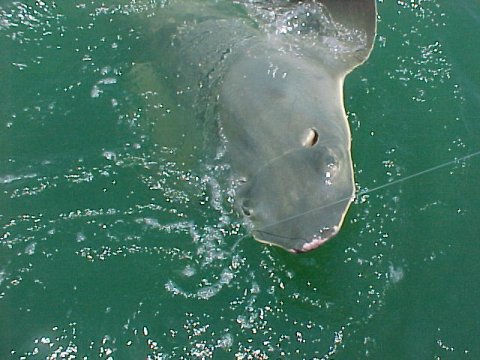 Look at this sawfish after someone removed its saw and the wound had healed up.
Look at this sawfish after someone removed its saw and the wound had healed up.
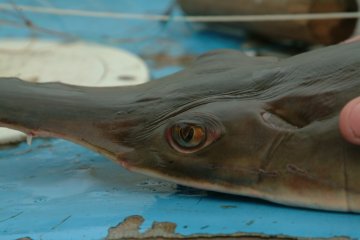
Eye and spiracleof a juvenile female smalltooth sawfish caught in Faka Union Bay